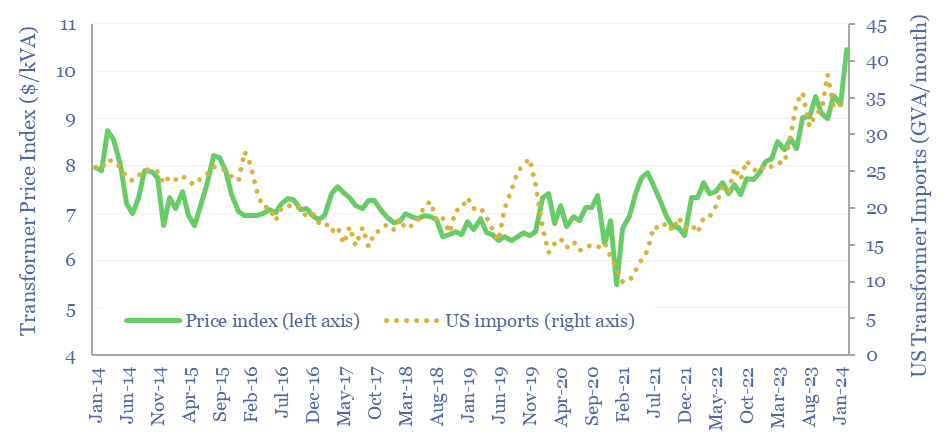Transformers are needed every time voltage steps up or down in the power grid. But lead times have now risen from 12-24 weeks to 1-3 years. And prices have risen 70%. Will these shortages structurally slow new energies and AI? Or improve transformer margins? Or is it just another boom-bust cycle? Answers are explored in this 15-page report.
Three years ago, we wrote an overview of transformers, which are used every time voltage steps up or down in the world’s power grids. As examples at both extremes, efficient power transmission requires high voltages at 200-800kV, while the sockets in your home power electrical appliances at a low, safe 120V (in the US, or 230V in Europe).
The central argument in our 2021 report was that the total capacity of transformers would double or more, and the number of transformers needed in the power grid could rise by 30x as part of the energy transition. The rationale is re-capped and updated on page 2.
Transformer shortages are biting by 2024. Lead times have risen from 12-24 weeks to 1-3 years. Prices have risen by 70%. We are concerned about power grid bottlenecks, powering the rise of AI, long interconnection times for wind and solar, and delays to power electronics order books, per pages 3-4.
Hence in this report, we have attempted to break down the bottlenecks across the transformer supply chain, to see which ones might be persistent; or conversely, which ones might resolve, covering design considerations (page 5), transformer materials (pages 6-7), specialized labor requirements (pages 8-9), the capex costs of new facilities (page 10) and ultimately IRR sensitivities for the costs of transformers (page 11).
If we follow other materials that matter in the energy transition — e.g., lithium, solar modules — then we can clearly see evidence for boom-bust cycles. Hence what are the risks of a boom-bust cycle for transformer manufacturing? Evidence is reviewed on pages 12-14.
Conclusions into transformer shortages, and companies across the supply chain, are summarized on page 15.

